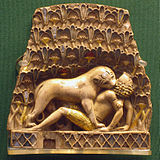- Art of Mesopotamia
-
Ancient art history
seriesMiddle East MesopotamiaAsia European prehistory PictsVisigothicClassical art Art of Mesopotamia has survived in the archaeological record from early hunter-gatherer societies (10th millennium BC) on to the Bronze Age cultures of the Sumerian, Akkadian, Babylonian and Assyrian empires. These empires were later replaced in the Iron Age by the Neo-Assyrian and Neo-Babylonian empires. Widely considered to be the cradle of civilization, Mesopotamia brought significant cultural developments, including the oldest examples of writing. A bas relief representing Naram-Sin has been found at Diyarbakır, in modern Turkey. An Assyrian artistic style distinct from that of Babylonian art, which was the dominant contemporary art in Mesopotamia, began to emerge c. 1500 BC and lasted until the fall of Nineveh in 612 BC. The characteristic Assyrian art form was the polychrome carved stone relief that decorated imperial monuments. The precisely delineated reliefs concern royal affairs, chiefly hunting and war making. Predominance is given to animal forms, particularly horses and lions, which are magnificently represented in great detail. Human figures are comparatively rigid and static but are also minutely detailed, as in triumphal scenes of sieges, battles, and individual combat. Among the best known of Assyrian reliefs are the lion-hunt alabaster carvings showing Assurnasirpal II (9th century BC) and Assurbanipal (7th century BC), both of which are in the British Museum. Guardian animals, usually lions and winged beasts with bearded human heads, were sculpted partially in the round for fortified royal gateways, an architectural form common throughout Asia Minor. At Nimrud carved ivories and bronze bowls were found that are decorated in the Assyrian style but were produced by Phoenician and Aramaean artisans. Exquisite examples of Assyrian relief carving may be seen at the British and Metropolitan museums.
Examples of Mesopotamian art Female figurine from Samarra, ca. 6000 BC"War"-panel of the Standard of Ur, ca. 2600 BCFragment of the Stele of the Vultures, Early Dynastic III period, 2600–2350 BCOne of the Nimrud ivories, Neo-Assyrian period, 9th–7th centuries BCSee also
- Akkadian literature
- Bassetki statue
- Burney Relief
- Mesopotamian religion
- Music of Mesopotamia
- Sumerian literature
- Warka Vase
Categories:- Assyrian art and architecture
- Sumerian art and architecture
- Mesopotamia
Wikimedia Foundation. 2010.




